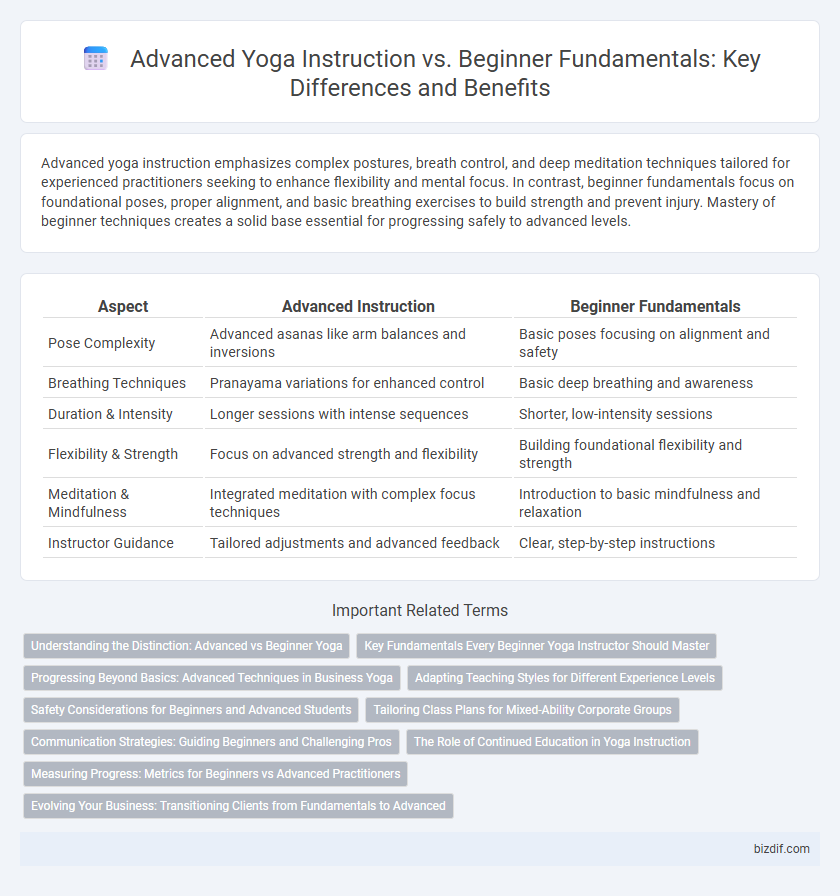Advanced yoga instruction emphasizes complex postures, breath control, and deep meditation techniques tailored for experienced practitioners seeking to enhance flexibility and mental focus. In contrast, beginner fundamentals focus on foundational poses, proper alignment, and basic breathing exercises to build strength and prevent injury. Mastery of beginner techniques creates a solid base essential for progressing safely to advanced levels.
Table of Comparison
| Aspect | Advanced Instruction | Beginner Fundamentals |
|---|---|---|
| Pose Complexity | Advanced asanas like arm balances and inversions | Basic poses focusing on alignment and safety |
| Breathing Techniques | Pranayama variations for enhanced control | Basic deep breathing and awareness |
| Duration & Intensity | Longer sessions with intense sequences | Shorter, low-intensity sessions |
| Flexibility & Strength | Focus on advanced strength and flexibility | Building foundational flexibility and strength |
| Meditation & Mindfulness | Integrated meditation with complex focus techniques | Introduction to basic mindfulness and relaxation |
| Instructor Guidance | Tailored adjustments and advanced feedback | Clear, step-by-step instructions |
Understanding the Distinction: Advanced vs Beginner Yoga
Advanced yoga instruction demands a deeper mastery of complex postures, breath control, and meditation techniques that build on foundational principles. Beginners focus primarily on learning alignment, basic breathing, and essential poses to establish a safe and effective practice. Understanding the distinction between advanced and beginner yoga allows practitioners to progress with proper technique and avoid injury.
Key Fundamentals Every Beginner Yoga Instructor Should Master
Mastering key fundamentals such as proper alignment, breath control, and foundational poses is essential for every beginner yoga instructor to ensure safety and build student confidence. Advanced instruction builds on these basics by integrating complex sequencing, deeper anatomy knowledge, and modifications for diverse student needs. Emphasizing fundamentals creates a strong teaching foundation that supports effective progression to advanced techniques.
Progressing Beyond Basics: Advanced Techniques in Business Yoga
Advanced business yoga instruction deepens practice through complex asanas, breath control, and meditation techniques tailored for workplace stress management. Emphasizing alignment, balance, and core strength enhances mind-body awareness, promoting productivity and focus. Mastery of these advanced methods supports sustained well-being and resilience in high-pressure professional environments.
Adapting Teaching Styles for Different Experience Levels
Adapting teaching styles for different experience levels in yoga instruction requires a nuanced approach that balances foundational alignment and advanced pose modifications. Beginner fundamentals emphasize clear, accessible guidance on breath control, basic postures, and safety to build confidence and body awareness. Advanced instruction integrates complex sequences, deeper pranayama techniques, and individualized adjustments to challenge experienced practitioners while preventing injury.
Safety Considerations for Beginners and Advanced Students
Safety considerations for beginners in yoga emphasize proper alignment, gradual progression, and the use of props to prevent injury while building foundational strength and flexibility. Advanced instruction requires heightened body awareness, controlled transitions, and mindful modifications to accommodate increased intensity and complex postures. In both levels, personalized guidance and attentive breathing techniques are essential to minimize risks and foster a safe, effective practice.
Tailoring Class Plans for Mixed-Ability Corporate Groups
Advanced yoga instruction integrates complex postures and breath control techniques to challenge experienced practitioners, while beginner fundamentals emphasize foundational poses and proper alignment to prevent injury. Tailoring class plans for mixed-ability corporate groups involves balancing skill levels by incorporating adaptable sequences and offering modifications to accommodate diverse fitness and experience levels. Effective instruction promotes inclusivity and progression, enhancing overall group engagement and well-being.
Communication Strategies: Guiding Beginners and Challenging Pros
Effective yoga instruction tailors communication strategies to skill level, emphasizing clear, simple cues and step-by-step guidance for beginners to build foundational postures safely. For advanced practitioners, instructors use precise, nuanced language that challenges alignment, breath control, and deeper engagement to refine practice. Adapting communication ensures optimal progression by addressing unique needs of both novice and experienced yogis.
The Role of Continued Education in Yoga Instruction
Continued education in yoga instruction bridges the gap between beginner fundamentals and advanced practice by deepening anatomical knowledge, refining alignment techniques, and expanding sequencing skills. Advanced instruction demands mastery of subtle breath control, complex poses, and therapeutic adjustments, which build upon the foundational skills acquired during initial training. Ongoing teacher training, workshops, and certifications ensure instructors maintain high teaching standards and adapt to evolving methodologies, fostering student safety and holistic growth.
Measuring Progress: Metrics for Beginners vs Advanced Practitioners
Measuring progress in yoga differs significantly between beginners and advanced practitioners, with beginners focusing on mastering foundational poses, breath control, and flexibility improvements as key metrics. Advanced instruction emphasizes deeper alignment, advanced balance, increased strength, and subtle breath retention techniques as indicators of development. Tracking progress through personalized goals, video analysis, and mindfulness assessment provides objective data for both levels, optimizing practice effectiveness.
Evolving Your Business: Transitioning Clients from Fundamentals to Advanced
Evolving your yoga business requires strategically guiding clients from beginner fundamentals to advanced instruction by emphasizing skill progression and personalized practice development. Fostering client retention involves offering tailored workshops and intermediate classes that build confidence while introducing complex poses and breathwork. Tracking client progress through assessments and feedback ensures seamless transitions, enhancing client satisfaction and promoting long-term growth in your yoga practice offerings.
Advanced instruction vs Beginner fundamentals Infographic

 bizdif.com
bizdif.com